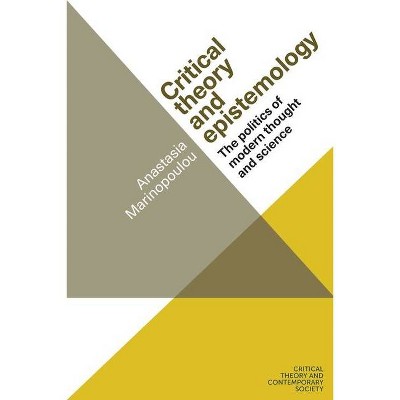Environment and Society - (Critical Introductions to Geography) 2nd Edition by Paul Robbins & John Hintz & Sarah A Moore (Paperback)

Similar Products
Products of same category from the store
AllProduct info
<p/><br></br><p><b> Book Synopsis </b></p></br></br><p>Substantially updated for the second edition, this engaging and innovative introduction to the environment and society uses key theoretical approaches to explore familiar objects.</p> <ul> <li>Features substantial revisions and updates for the second edition, including new chapters on E waste, mosquitoes and uranium, improved maps and graphics, new exercises, shorter theory chapters, and refocused sections on environmental solutions</li> <li>Discusses topics such as population and scarcity, commodities, environmental ethics, risks and hazards, and political economy and applies them to objects like bottled water, tuna, and trees</li> <li>Accessible for students, and accompanied by in-book and online resources including exercises and boxed discussions, an online test bank, notes, suggested reading, and website links for enhanced understanding</li> <li>Offers additional online support for instructors, including suggested teaching models, PowerPoint slides for each chapter with full-color graphics, and supplementary images and teaching material</li> </ul><p/><br></br><p><b> From the Back Cover </b></p></br></br><p>"Robbins, Hintz, and Moore have taken something excellent and made it even better. It remains as comprehensive yet accessible as the first edition, and by adding new material about human-nature relations, the authors ensure that the second edition reflects important recent developments in thinking and practice."</br> Noel Castree, <i>University of Manchester</i> <p>"This masterful synthesis of environment-society scholarship brings together cutting-edge ways of thinking about nature/society entanglements with highly grounded objects of exploration -- from lawns to bottled water to uranium. The dynamic and accessible writing style belies the book's empirical and theoretical sophistication. For upper-level undergrads and lower-level graduate students of environment-society relations, this new edition remains the 'go-to' text in the field."</br> Kendra McSweeny, <i>Ohio State University Columbus</i> <p>"As an introductory text reflecting contemporary scholarship via plural perspectives and hybrid objects, Environment and Society continues to innovate."</br> Jim Proctor, <i>Lewis & Clark College</i> <p>This engaging and innovative introduction to the environment and society uses key theoretical approaches to explore familiar objects. It takes topics such as population and scarcity, commodities, environmental ethics, risks and hazards, and political economy, and then applies these to objects ranging from bottled water and tuna to trees and French fries. The second edition succeeds in maintaining its balance between theory and application, but now also offers a number of enhanced features. Substantial revisions include new chapters on e-waste, lawns, and uranium; a greater diversity of case studies; improved maps and graphics; new exercises; shorter theory chapters; refocused highlight sections on environmental solutions; and a range of online student resources at www.wiley.com/go/environmentandsociety, including a test bank, notes, suggested reading, and research links. <p>Students have long appreciated the innovative and engaging approach that <i>Environment and Society</i> brings to the study of contemporary environmental challenges. Offering insightful and accessible coverage of the key issues in this important field, this book will change the way students think about the relationship between the environment and society today.<p/><br></br><p><b> Review Quotes </b></p></br></br><br>new edition textbooks are not reviewed<br><p/><br></br><p><b> About the Author </b></p></br></br><p><b>Paul Robbins</b> is Professor and Director of the Nelson Institute for Environmental Studies, University of Wisconsin-Madison. His research interests include understanding human-environment systems, the influence non-humans have on human behavior and organization, and the implications these interactions hold for ecosystem health, local communities, and social justice. He is the author of <i>Political Ecology: A Critical Introduction</i> (2nd edition, Wiley Blackwell, 2012) and <i>Lawn People: How Grasses, Weeds, and Chemicals Make Us Who We Are</i> (2007). <p><b>John Hintz</b> is Associate Professor of Environmental, Geographic, and Geological Sciences at the Bloomsburg University of Pennsylvania. His current research focuses on land-use conflicts, environmental policy, and the US environmental movement. He has published in a number of journals, including <i>Capitalism Nature Socialism</i> and <i>Ethics, Place & Environment</i>. <p><b>Sarah A. Moore</b> is Assistant Professor in the Department of Geography at the University of Wisconsin-Madison. Her research focuses on urban development politics, urban environmental issues, and environmental justice inthe United States and Latin America. Her publications include articles in numerous journals including <i>Progress in Human Geography, The Professional Geographer</i>, and <i>Society and Natural Resources.</i>
Price History
Cheapest price in the interval: 45.99 on October 27, 2021
Most expensive price in the interval: 45.99 on December 20, 2021
Price Archive shows prices from various stores, lets you see history and find the cheapest. There is no actual sale on the website. For all support, inquiry and suggestion messages communication@pricearchive.us




















